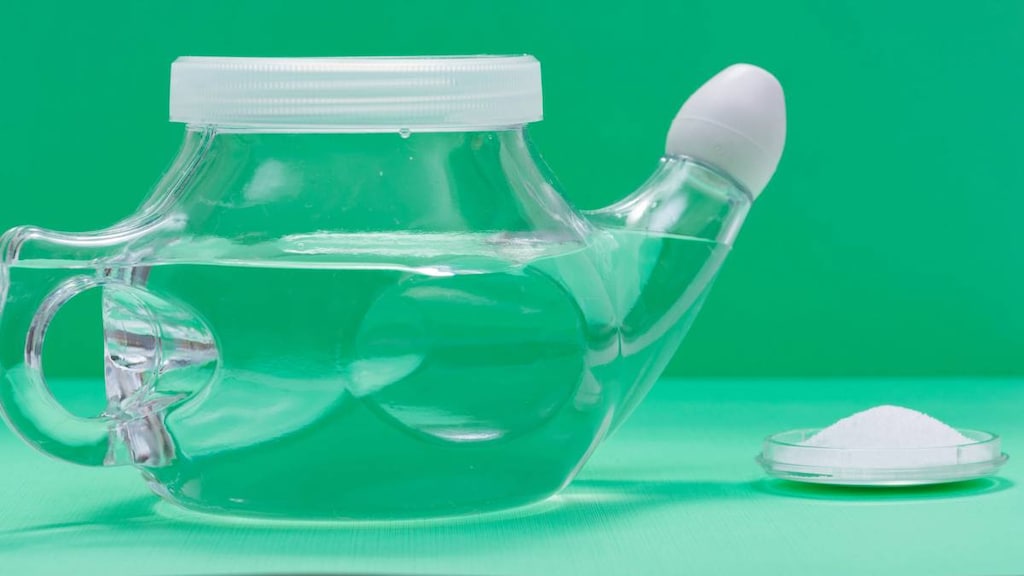Dosage Forms
Excipient information presented when available (limited, particularly for generics); consult specific product labeling. [DSC] = Discontinued product
Solution, Nasal, as hydrochloride:
4-Way Fast Acting: 1% (14.8 mL [DSC], 29.6 mL) [contains benzalkonium chloride]
4-Way Menthol: 1% (14.8 mL, 29.6 mL) [contains benzalkonium chloride, menthol, polysorbate 80]
Afrin Childrens: 0.25% (15 mL [DSC])
Nasal Four: 1% (29.6 mL) [contains benzalkonium chloride]
Neo-Synephrine Cold & Sinus: 0.25% (15 mL [DSC]); 0.5% (15 mL [DSC], 21 mL [DSC]); 1% (15 mL [DSC]) [contains benzalkonium chloride]
Rhinall: 0.25% (30 mL [DSC], 40 mL [DSC])
Pharmacology
Mechanism of Action
Potent, direct-acting alpha-adrenergic agonist with virtually no beta-adrenergic activity; produces local vasoconstriction resulting in nasal decongestion.
Pharmacokinetics/Pharmacodynamics
Onset of Action
Intranasal: ≤2 minutes (Chua 1989)
Duration of Action
Intranasal: 2.5 to 4 hours (dose dependent) (Chua 1989)
Use: Labeled Indications
Nasal congestion: Temporary relief of nasal congestion due to the common cold, hay fever, or other upper respiratory allergies (allergic rhinitis).
Use: Off Label
Topical vasoconstriction in nasal proceduresc
Data from a prospective randomized clinical trial in adult patients undergoing elective nasal septoplasty suggests that topical 0.5% phenylephrine is as effective as 4% cocaine for topical vasoconstriction during nasal surgery AlHaddad 2013. Use of phenylephrine spray followed by lidocaine jelly prior to nasal intubation was found to reduce procedural pain and discomfort in one study Singer 1999. Various administration techniques (eg, cotton soaked pledgets, spray) and combination with other local anesthetics (eg, lidocaine) are described in the literature Higgins 2010. Evidence, however, is limited to studies with small numbers of patients and case reports. Therefore, specific dosing cannot be provided. Additional data may be necessary to further define the role of topical phenylephrine in this setting.
Based on safety issues with topical phenylephrine in surgical settings, the amount of phenylephrine needed to achieve vasoconstriction should be minimized Groudine 2000. Some do not recommend the use of topical phenylephrine during endoscopic sinus surgery due to hypertension after application and some fatalities (especially in the pediatric population); instead other agents are recommended (eg, oxymetazoline) Higgins 2010.
Contraindications
OTC labeling: When used for self-medication, do not use if hypersensitive to phenylephrine or any component of the formulation.
Dosage and Administration
Dosing: Adult
Nasal congestion: Intranasal: 0.25% to 1% solution: Instill 2 to 3 sprays in each nostril no more than every 4 hours for ≤3 days.
Dosing: Geriatric
Refer to adult dosing.
Dosing: Pediatric
Nasal congestion: Note: Therapy should not exceed 3 days:
Infants and Children <2 years: Limited data available: 0.5% solution: Intranasal: Instill 0.1 mL in each nostril as a single dose (Ralston 2008; Turner 1996). In a double-blind, placebo-controlled trial in 20 infants (mean age: 4 months) with bronchiolitis results showed, improved respiratory scores and oxygen saturation; however, statistical significance was not reached (Ralston 2008). In another randomized, double-blind, placebo-controlled trial, 23 pediatric patients (age range: 6 to 18 months) with the common cold showed improvement in nasal obstruction which was not considered significant; no effect on middle ear pressures was observed (Turner 1996).
Children ≥2 years:
2 to <6 years: 0.125% solution: Intranasal: Instill 1 drop in each nostril every 2-4 hours as needed. Note: Consult product specific information for further details.
Little Noses Decongestant: Instill 2 to 3 drops in each nostril every 4 hours as needed
6 to 12 years: 0.25% solution: Intranasal: Instill 1 to 3 sprays in each nostril every 4 hours as needed
Adolescents: 0.25% to 1% solutions: Intranasal: Instill 1 to 3 drops or sprays every 4 hours as needed
Administration
For intranasal use only. Blow nose to clear nostrils before use; spray or drop solution into each nostril while gently occluding the other. Wipe nozzle clean after each use.
Storage
Store at 20ºC to 25ºC (68ºF to 77ºF); protect from light.
Drug Interactions
Alpha1-Blockers: May diminish the vasoconstricting effect of Alpha1-Agonists. Similarly, Alpha1-Agonists may antagonize Alpha1-Blocker vasodilation. Monitor therapy
AtoMOXetine: May enhance the hypertensive effect of Sympathomimetics. AtoMOXetine may enhance the tachycardic effect of Sympathomimetics. Monitor therapy
Cannabinoid-Containing Products: May enhance the tachycardic effect of Sympathomimetics. Exceptions: Cannabidiol. Monitor therapy
Cocaine (Topical): May enhance the hypertensive effect of Sympathomimetics. Management: Consider alternatives to use of this combination when possible. Monitor closely for substantially increased blood pressure or heart rate and for any evidence of myocardial ischemia with concurrent use. Consider therapy modification
Doxofylline: Sympathomimetics may enhance the adverse/toxic effect of Doxofylline. Monitor therapy
Ergot Derivatives: May enhance the hypertensive effect of Alpha1-Agonists. Ergot Derivatives may enhance the vasoconstricting effect of Alpha1-Agonists. Exceptions: Ergoloid Mesylates; Nicergoline. Avoid combination
Esketamine: Decongestants (Nasally Administered) may diminish the therapeutic effect of Esketamine. Management: Patients who require a nasal decongestant on an esketamine dosing day should administer the nasal decongestant at least 1 hour before esketamine. Consider therapy modification
FentaNYL: Alpha1-Agonists may decrease the serum concentration of FentaNYL. Specifically, fentanyl nasal spray serum concentrations may decrease and onset of effect may be delayed. Monitor therapy
Guanethidine: May enhance the arrhythmogenic effect of Sympathomimetics. Guanethidine may enhance the hypertensive effect of Sympathomimetics. Monitor therapy
Iobenguane Radiopharmaceutical Products: Alpha1-Agonists may diminish the therapeutic effect of Iobenguane Radiopharmaceutical Products. Management: Discontinue all drugs that may inhibit or interfere with catecholamine transport or uptake for at least 5 biological half-lives before iobenguane administration. Do not administer these drugs until at least 7 days after each iobenguane dose. Avoid combination
Linezolid: May enhance the hypertensive effect of Sympathomimetics. Management: Reduce initial doses of sympathomimetic agents, and closely monitor for enhanced pressor response, in patients receiving linezolid. Specific dose adjustment recommendations are not presently available. Consider therapy modification
Monoamine Oxidase Inhibitors: May enhance the hypertensive effect of Alpha1-Agonists. While linezolid is expected to interact via this mechanism, management recommendations differ from other monoamine oxidase inhibitors. Refer to linezolid specific monographs for details. Exceptions: Linezolid. Avoid combination
Solriamfetol: Sympathomimetics may enhance the hypertensive effect of Solriamfetol. Monitor therapy
Sympathomimetics: May enhance the adverse/toxic effect of other Sympathomimetics. Monitor therapy
Tedizolid: May enhance the hypertensive effect of Sympathomimetics. Tedizolid may enhance the tachycardic effect of Sympathomimetics. Monitor therapy
Tricyclic Antidepressants: May enhance the therapeutic effect of Alpha1-Agonists. Tricyclic Antidepressants may diminish the therapeutic effect of Alpha1-Agonists. Monitor therapy
Adverse Reactions
Frequency not defined.
Nasal: Burning, nasal discharge, sneezing, stinging
Warnings/Precautions
Concerns related to adverse effects:
- Local nasal effects: Temporary discomfort such as burning, stinging, sneezing, or an increase in nasal discharge may occur.
- Rebound nasal congestion: Frequent or prolonged use may cause nasal congestion to recur or worsen.
Disease-related concerns:
- Cardiovascular disease: Use with caution in patients with hypertension or heart disease.
- Diabetes mellitus: Use with caution in patients with diabetes mellitus.
- Thyroid disease: Use with caution in patients with thyroid disease.
- Prostatic hyperplasia/Urinary obstruction: Use with caution in patients with prostatic hyperplasia and/or GU obstruction.
Concurrent drug therapy issues:
- Drug-drug interactions: Potentially significant interactions may exist, requiring dose or frequency adjustment, additional monitoring, and/or selection of alternative therapy. Consult drug interactions database for more detailed information.
Other warnings/precautions:
- Self-medication (OTC use): When used for self-medication (OTC), do not use >3 days; discontinue use and notify health care provider if nervousness, dizziness, or sleeplessness occurs or if symptoms do not improve within 3 days; do not use if solution is brown or contains precipitates; do not exceed recommended dosages or use with other products containing decongestants.
Pregnancy
Pregnancy Considerations
When administered intravenously, phenylephrine crosses the placenta. Decongestants are not the preferred agents for the treatment of rhinitis during pregnancy. Short-term use (<3 days) of intranasal phenylephrine may be beneficial to some patients, although its safety during pregnancy has not been studied (Wallace, 2008).
Patient Education
What is this drug used for?
- It is used to treat nose stuffiness.
- It may be given to you for other reasons. Talk with the doctor.
Frequently reported side effects of this drug
- Burning
- Stinging
- Sneezing
- Runny nose
- Nasal irritation
Other side effects of this drug: Talk with your doctor right away if you have any of these signs of:
- A significant reaction like wheezing; chest tightness; fever; itching; bad cough; blue skin color; seizures; or swelling of face, lips, tongue, or throat.
Note: This is not a comprehensive list of all side effects. Talk to your doctor if you have questions.
Consumer Information Use and Disclaimer: This information should not be used to decide whether or not to take this medicine or any other medicine. Only the healthcare provider has the knowledge and training to decide which medicines are right for a specific patient. This information does not endorse any medicine as safe, effective, or approved for treating any patient or health condition. This is only a brief summary of general information about this medicine. It does NOT include all information about the possible uses, directions, warnings, precautions, interactions, adverse effects, or risks that may apply to this medicine. This information is not specific medical advice and does not replace information you receive from the healthcare provider. You must talk with the healthcare provider for complete information about the risks and benefits of using this medicine.

